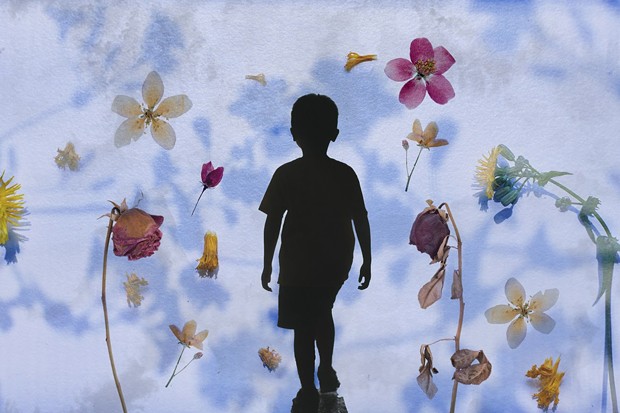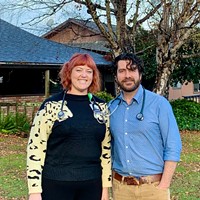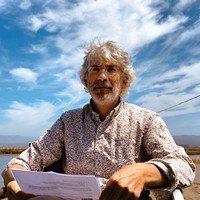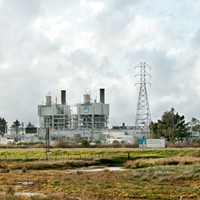Tuesday, November 29, 2022
Screening for Adverse Childhood Experiences is Increasing, but are Patients Getting Treatment?
Posted By Elizabeth Aguilera, CALmatters on Tue, Nov 29, 2022 at 9:08 AM
Today the number of doctors screening patients for adverse experiences is growing, but the state is failing to track whether patients receive the follow-up services or support they might need. State officials say they are working on identifying this information about patients from state medical databases, but it could be a few years off.
More than 6 in 10 Californians have experienced at least one adverse childhood experience, and 1 in 6 have experienced four or more, according to a state report. These include physical, emotional or sexual abuse, physical or emotional neglect, growing up in a home with substance use, mental illness, incarceration, parental separation or divorce or intimate partner violence. Research shows the higher the number of adverse experiences, the higher the risk of chronic health or mental health conditions later in life.
Since the Office of the California Surgeon General began the program, about 900,000 children and adults on Medi-Cal, the state’s health insurance plan for low-income people, have been screened. The program, known as ACEs Aware, tracks only the screenings done by Medi-Cal doctors who choose to incorporate them into their practice. Medi-Cal reimburses providers $29 per screening. Last year, the state mandated private insurers pay for screenings too, but the state does not require or track those.
After screening a patient, physicians may make referrals to therapists, nutritionists, social workers and other support services. A score of four adverse childhood experiences is used as a marker for doctors to offer referrals but they assess patients based on a wide variety of factors. They may make referrals for someone with one adverse experience or only talk with someone with six adverse experiences because they have been able to buffer their experiences.
Physicians aren’t required to report whether patients receive support services or if the services are available to them. That’s part of the challenge. The state’s serious shortage of mental health professionals, social workers and other support health care workers, like nutritionists and physical therapists, makes it even harder for physicians to make referrals and for patients to get help.
“Right now, with our patients, we give them a referral or a list of options/therapists,” said Reshmi Basu, a pediatrician and president-elect of the American Academy of Pediatricians – Orange County Chapter. “But once we do that, we don’t know what happens. We don’t know if they are taking new patients.”
The California Department of Health Care Services oversees the ACEs Aware program with the Office of the California Surgeon General. Right now, the department “neither collects nor reports on data about actions taken based on an ACE screening,” wrote spokesperson Anthony Cava in email.
The state has piloted smaller efforts across California to try to determine what happens after someone is screened. That information is not available yet, said Karen Mark, medical director at the California Department of Health Care Services.
“We are recognizing issues that the patient has been burdened with forever and talking about them in a normal way.”
Edward Machtinger, physician, professor of medicine and co-principal investigator of the UCLA-UCSF ACEs Aware Family Resiliency Network
When the initiative began, the program created a collaborative of 47 clinics to study when and how screenings take place, how they work and what happens afterward for patients, said Edward Machtinger, a physician, professor of medicine and co-principal investigator of the UCLA-UCSF ACEs Aware Family Resiliency Network, the organization running the program for the state.
He said that researchers have evaluated data from the collaborative, but it is pending review. The research shows providers took action more often when patients had four or more adverse experiences, he said. In those cases, the screenings led to different actions — from referrals to getting support services.
“It changes the dynamic in the encounter,” Machtinger said. “We are recognizing issues that the patient has been burdened with forever and talking about them in a normal way.”
A 400-page report written in 2020 by former California Surgeon General Nadine Burke Harris includes a future plan to review how the program is working, from screenings and referrals to whether patients connect with follow-up services.
Burke Harris launched the Adverse Childhood Experiences initiative shortly after Gov. Gavin Newsom appointed her in 2019. Her advocacy and the in-depth report she produced have prompted the state to incorporate adverse childhood experiences in various health initiatives, including a program to increase mental health services for children and youth, before she left her post earlier this year. She said she resigned to focus on caring for herself and her family. Since leaving her position, she has continued to speak about adverse childhood experiences publicly.
She said an external independent review of the ACEs Aware program has always been part of the plan, but it’s still too soon. She expects a review sometime after the fifth year of the program.
“We don’t just want to know if they are screened. We want to know if they got the services they needed,” she said in a recent interview. She said setting up systems takes time. “You do it in phases.”
The future review is expected to be an outside evaluation of how the program is working and whether patients received the follow-up care they need.
“We don’t just want to know if they are screened. We want to know if they got the services they needed.”
Nadine Burke Harris, former California surgeon general
Experts say more extensive data about follow-up care is critical to ensuring the state program is working.
Information about what happens after a screening, data about whether patients are able to access follow-up support and their health outcomes would help reveal the benefits of universal screening, said Elizabeth Magnan, associate professor of family and community medicine and a family physician at UC Davis Health. “Or help us make sure there are enough providers and enough coverage.”
Magnan co-authored a review of the program last year, published in the Journal of the American Board of Family Medicine. It found limited evidence that screenings increase referrals to support services and insufficient evidence of whether screenings result in using those services or improve health outcomes.
Cava, the Health Care Services Department spokesperson, wrote that the state is measuring success through the number of Medi-Cal providers who complete training, the number who plan to incorporate screenings into their practice, and the number of screenings done through Medi-Cal.
“It’s too soon to assess whether the goal of cutting (adverse childhood experiences) and toxic stress in half in one generation will be met,” Cava wrote. He also wrote that the initiative has met other goals, including raising awareness of adverse experiences and getting providers to start screening or plan to start screening.
Burke Harris said the most important part of setting up the program is the ongoing training for doctors on how to screen patients and connect them to help if they need it.
“Health really happens outside the four walls of any clinic,” said Rhonda Smith, executive director of the California Black Health Network, which received a grant from the initiative in 2020 to educate health care providers about Black maternal health and connections to adverse childhood experiences. “When an individual shows up at an exam room, there is a lot of stuff they may carry with them into that exam room that they deal with on a day-to-day basis to survive.”
Since 2020, the state has budgeted more than $225 million for ACEs Aware provider training and screening, according to the Health Care Services Department. The state has also awarded $64.5 million in grants to county health departments and nonprofits to train providers, including doctors, nurse practitioners, physical therapists and others who treat patients directly. The grants have also funded education for health care workers about adverse childhood experiences, plans for preventing adverse experiences and identifying gaps in services.
So far, 26,900 providers have gone through the training. Of those, 12,100 are Medi-Cal clinicians, according to the initiative.
In October, the state reported that 899,000 Medi-Cal beneficiaries were screened between January 2020 and December 2021. The state doesn’t have data yet for this year. Most people screened were under 21. They account for about 13 percent of children and youth on Medi-Cal. Of those, 5 percent reported four or more adverse experiences.
Before Burke Harris left, the initiative was outsourced to the University of California and is managed by the UCLA/UCSF ACEs Aware Family Resilience Network.
One of the goals of screening is to prevent future adverse experiences. For adults with children it’s critical, said Emily Williams, CEO of the ACEs Aware Family Resiliency Network, during a webinar the organization hosted in September.
“One of the best ways to prevent (adverse experiences) in kids is to take care of parents and help them treat their own mental illness, their substance use disorder, help them not die, help them not go to prison, help them be safe and strong parents. So they can help prevent the intergenerational transmissions of (adverse experiences) to their kids,” she said during the webinar. “That is a huge role for providers.”
The state reports that people with four or more adverse experiences are more likely to experience depression, become addicted to drugs or alcohol or become homeless. They also have twice the risk of heart disease, triple the risk of chronic lung disease and a 70 percent higher risk of kidney disease. This is why providers connect patients with additional services when they report four or more adverse experiences.
When the program launched, Burke Harris said the state’s health-related costs of adverse childhood experiences and toxic stress totaled $112.5 billion annually. That tab includes $10.5 billion in direct health care costs and $102 billion related to the cost of living with a disease, including premature death and lost years of productivity due to disability.
The method of screening varies based on the patient’s age. Parents fill out the form for children under 12. There’s also a teen questionnaire and an adult version, and an option for those who don’t want to be specific. They can read through a questionnaire, not check any boxes and write their total number of adverse experiences at the bottom of the sheet.
Machtinger said the state is in the process of finding a way to use existing Medi-Cal data to link screenings and adverse childhood experience scores to the types of services a patient receives after a screening. He said it could take a few years to set up a computerized system to track the outcomes.
For now, Machtinger said, one of the best ways to analyze how it’s working is through small organizations that received grants focused on how patients are accessing services at a local or clinic level.
“Trauma doesn’t have to cause health problems in the future.”
Reshmi Basu, pediatrician and president-elect of the American Academy of Pediatricians – Orange County Chapter
What comes after the screening makes the biggest difference for patients, said Basu, the president-elect of the Orange County pediatricians academy. The organization has received several grants over the last three years including the most recent focused on ensuring there are support services available to patients and whether they access them.
Basu’s organization is using last year’s ACEs Aware grant to partner with the OC Trauma-Informed Network of Care to develop a website for doctors and patients to find services and support. The site will also let the physician know if the patient received services.
“We can have an effect by doing these things,” Basu said. “Trauma doesn’t have to cause health problems in the future.”
Basu said therapy or referral services are not always necessary when adverse childhood experiences happen. Suppose a parent says their toddler has experienced trauma. Depending on the age of the child and whether the child is having health symptoms related to the trauma, like stress, the doctor might share a handout with advice for good sleep, a nurturing environment, healthy nutrition, and time outdoors to help support their child.
For adults, the response is similar, and also depends on whether the person needs or is ready for intervention, Burke Harris said.
Burke Harris said sometimes the treatment is a patient’s conversation with their primary care providers and the support they can provide. When referrals are needed, she hopes physicians would eventually treat follow-up care for toxic stress from adverse childhood experiences the same as they would a patient who needs continued care for diabetes or high blood pressure.
“So much of our health care system is transactional. You take a test, get your results and you get out,” said Mayra Alvarez, president of The Children’s Partnership, a California child policy and advocacy organization. “For many of our communities, it matters to feel a sense of community. Being able to shift our health care system in that direction is part of the solution. To offer safer spaces for people to feel that they can find solutions to the challenges they have.”






































